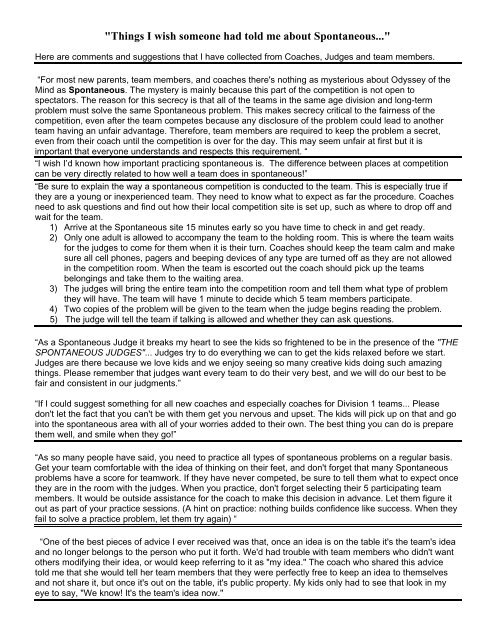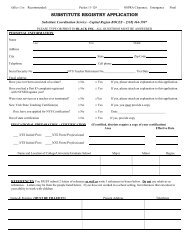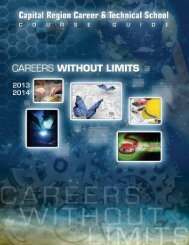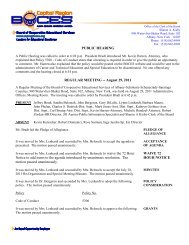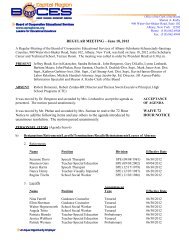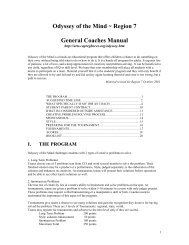Things I Wish Someone Had Told Me About Spontaneous!
Things I Wish Someone Had Told Me About Spontaneous!
Things I Wish Someone Had Told Me About Spontaneous!
Create successful ePaper yourself
Turn your PDF publications into a flip-book with our unique Google optimized e-Paper software.
"<strong>Things</strong> I wish someone had told me about <strong>Spontaneous</strong>..."<br />
Here are comments and suggestions that I have collected from Coaches, Judges and team members.<br />
“For most new parents, team members, and coaches there's nothing as mysterious about Odyssey of the<br />
Mind as <strong>Spontaneous</strong>. The mystery is mainly because this part of the competition is not open to<br />
spectators. The reason for this secrecy is that all of the teams in the same age division and long-term<br />
problem must solve the same <strong>Spontaneous</strong> problem. This makes secrecy critical to the fairness of the<br />
competition, even after the team competes because any disclosure of the problem could lead to another<br />
team having an unfair advantage. Therefore, team members are required to keep the problem a secret,<br />
even from their coach until the competition is over for the day. This may seem unfair at first but it is<br />
important that everyone understands and respects this requirement. “<br />
“I wish I’d known how important practicing spontaneous is. The difference between places at competition<br />
can be very directly related to how well a team does in spontaneous!”<br />
“Be sure to explain the way a spontaneous competition is conducted to the team. This is especially true if<br />
they are a young or inexperienced team. They need to know what to expect as far the procedure. Coaches<br />
need to ask questions and find out how their local competition site is set up, such as where to drop off and<br />
wait for the team.<br />
1) Arrive at the <strong>Spontaneous</strong> site 15 minutes early so you have time to check in and get ready.<br />
2) Only one adult is allowed to accompany the team to the holding room. This is where the team waits<br />
for the judges to come for them when it is their turn. Coaches should keep the team calm and make<br />
sure all cell phones, pagers and beeping devices of any type are turned off as they are not allowed<br />
in the competition room. When the team is escorted out the coach should pick up the teams<br />
belongings and take them to the waiting area.<br />
3) The judges will bring the entire team into the competition room and tell them what type of problem<br />
they will have. The team will have 1 minute to decide which 5 team members participate.<br />
4) Two copies of the problem will be given to the team when the judge begins reading the problem.<br />
5) The judge will tell the team if talking is allowed and whether they can ask questions.<br />
“As a <strong>Spontaneous</strong> Judge it breaks my heart to see the kids so frightened to be in the presence of the "THE<br />
SPONTANEOUS JUDGES"... Judges try to do everything we can to get the kids relaxed before we start.<br />
Judges are there because we love kids and we enjoy seeing so many creative kids doing such amazing<br />
things. Please remember that judges want every team to do their very best, and we will do our best to be<br />
fair and consistent in our judgments.”<br />
“If I could suggest something for all new coaches and especially coaches for Division 1 teams... Please<br />
don't let the fact that you can't be with them get you nervous and upset. The kids will pick up on that and go<br />
into the spontaneous area with all of your worries added to their own. The best thing you can do is prepare<br />
them well, and smile when they go!”<br />
“As so many people have said, you need to practice all types of spontaneous problems on a regular basis.<br />
Get your team comfortable with the idea of thinking on their feet, and don't forget that many <strong>Spontaneous</strong><br />
problems have a score for teamwork. If they have never competed, be sure to tell them what to expect once<br />
they are in the room with the judges. When you practice, don't forget selecting their 5 participating team<br />
members. It would be outside assistance for the coach to make this decision in advance. Let them figure it<br />
out as part of your practice sessions. (A hint on practice: nothing builds confidence like success. When they<br />
fail to solve a practice problem, let them try again) “<br />
“One of the best pieces of advice I ever received was that, once an idea is on the table it's the team's idea<br />
and no longer belongs to the person who put it forth. We'd had trouble with team members who didn't want<br />
others modifying their idea, or would keep referring to it as "my idea." The coach who shared this advice<br />
told me that she would tell her team members that they were perfectly free to keep an idea to themselves<br />
and not share it, but once it's out on the table, it's public property. My kids only had to see that look in my<br />
eye to say, "We know! It's the team's idea now."
“<strong>Spontaneous</strong> Rules<br />
1) Listen! Pay close attention to the judges as they read the problem.<br />
2) Expect the unexpected. Train for the unusual!<br />
3) Evaluate Quality vs. Quantity for responses and do the math for scoring<br />
4) Scoring is critical. Make sure you understand it.<br />
“Verbal problems seem to have been evolving with limiting conditions as matter of necessity for the Judge’s<br />
sake. If you want to know why, try scoring a fast verbal problem and keeping up with the kids! With a well<br />
coached team you don't get much time to decide if it’s a common or creative response. My experience as a<br />
judge is limited to just a few years and can tell you this change is very welcome. What this means is that<br />
speed is not as important as creativity. While I don't claim to know what the best method for developing<br />
creativity might be, I do know that teaching the kids to not jump into answers is very important. When you<br />
practice with your team, ask them to read the problem carefully and figure out what limits the responses. Is<br />
it cards to flip over? Is it something they pass around?<br />
“They should also be careful to follow the instructions. For instance, if the verbal problem specifically says<br />
that “the next team member must wait to turn over the next card until the last response was given” the team<br />
needs to be very careful. Judges will notice if this rule is ignored and they will stop the team and make them<br />
go back. This will cost the team time, and time can often be the determining factor in the number of<br />
responses the team may give.”<br />
“Penalties (as in point reductions for breaking a rule) are not imposed in spontaneous. However, any<br />
intervention by the judges that uses up some of the team’s response time is reducing the time available for<br />
the team to score. While not as obvious as a written penalty in long term the result can be just as significant.<br />
This is a very common problem for inexperienced teams when they are given a verbal problem to solve.<br />
This is because any inappropriate or repeated responses will require the judges to ask the team member to<br />
give another response. If the judges can’t hear or understand the response the judges will ask the team<br />
member to repeat the response.”<br />
Here are the three standard interventions that Judges will use on VERBAL SPONTANEOUS problems.<br />
Don’t forget to use these phrases when practicing verbal spontaneous. This will get the team prepared to<br />
hear these same phrases in competition and thus save them precious TIME!…<br />
“Unclear…..<br />
“Inappropriate….<br />
“Duplicate….<br />
Say again”<br />
Clarify or give another response”<br />
Give another response”<br />
Separate scores for creativity and teamwork are sometimes used in spontaneous hands on problems and /<br />
or verbal - hands on problems. It is critical that the team understands what these terms mean and how<br />
these aspects may be scored. This is a very important part of the total spontaneous score and it could well<br />
be that the additional scoring for the creativity or teamwork involved in the teams performance could be the<br />
deciding factor in determining the top scores. When the score for the technical part of the teams solution<br />
depends on how long or how tall what they create is the score received by several teams may be very<br />
close. The following two pages were developed and revised over the last 9 years and are intended to clarify<br />
this part of scoring.
<strong>Spontaneous</strong> Creativity notes for Coaches<br />
In spontaneous “Hands On” or “Verbal / Hands On” problems, scoring for creativity is<br />
sometimes used. The creative aspect of the solution is not necessarily the skill in the<br />
presentation, or even how well the solution may actually work. Since most teams will be<br />
successful in creating some sort of solution to the problem, deciding which team has been<br />
more creative than another will be the subjective opinion of the judges. Judges are very<br />
open-minded; we try to score for the creativity in what was attempted, successful or not!<br />
Does it work? The more creative solutions can sometimes fail to solve the technical part of<br />
the problem, especially when the team is focused on getting a specific problem resolved.<br />
So if the problem includes scoring for creativity this method will give the team credit for the<br />
creativity they used even if the solution does not work well.<br />
The scoring criteria for most problems will be such that the raw score for a lack of a<br />
working solution will be reflected only in that portion of the scoring.<br />
EXAMPLES OF SCORING CREATIVITY<br />
SCORE RANGE<br />
1-10 1-15 1-20 1-25<br />
1-2 1-3 1-4 1-5<br />
3-4 4-6 5-8 6-10<br />
5-6 7-9 9-12 11-15<br />
7-8 10-12 13-16 16-20<br />
9-10 13-15 17-20 21-25<br />
Common solution with very minimum creativity. Little or no<br />
enhancement added and the teams solution was lacking<br />
inspiration, creativity or imagination. Risks were not taken or<br />
even avoided deliberately.<br />
Fair solution with some creative elements that were of little<br />
importance to the team’s solution. There was some<br />
enhancement added but the teams solution showed only a little<br />
inspiration and imagination. Little or no risks were considered<br />
or taken.<br />
Good solution and creative elements tied into the team’s<br />
solution. The enhancements that were added helped express the<br />
teams’ use of creative elements to enhance solution. Moderate<br />
imagination and creativity. Few or minor risks taken.<br />
Very good solution. Team worked hard on adding<br />
enhancements. Creative thought process was important to the<br />
way the solution was developed and team members used<br />
initiative and took moderate risks.<br />
Outstanding imagination and enhancements used in truly<br />
inspired solution. Creativity was paramount in the team’s unique<br />
solution. Big risks were taken and unusual twists were used to<br />
solve the problem.<br />
Although rare, any team worthy of the top score could even be considered for nomination for the<br />
Ranatra Fusca award.<br />
Zero is not an option. IE: If the range is 1 to 10, the lowest score will be 1.
<strong>Spontaneous</strong> Teamwork notes for Coaches<br />
While teamwork is always important, in spontaneous “hands on” or “verbal/hands on”<br />
problems, scoring for teamwork may be used in addition to the score for the actual<br />
problems solution. Even if the team’s solution fails to solve the actual problem the score for<br />
a lack of a working solution will only be reflected in that portion of the scoring. The team<br />
will still be able to keep the teamwork points they earn for working together.<br />
Judges are trained to be open-minded; they decide the teamwork score by watching and<br />
listening to the team as they work on their solution. NOTE: It is VERY important for the team<br />
to avoid whispering as this puts the judges at an disadvantage and the team may not<br />
receive the score that they deserve.<br />
Every aspect of how well the team functions together is considered by the judges. To give<br />
you an idea how they are scored see the examples in the table below.<br />
EXAMPLES OF SCORING TEAMWORK<br />
SCORE RANGE<br />
1-10 1-15 1-20 1-25<br />
1-2 1-3 1-4 1-5<br />
3-4 4-6 5-8 6-10<br />
5-6 7-9 9-12 11-15<br />
7-8 10-12 13-16 16-20<br />
9-10 13-15 17-20 21-25<br />
Little sharing of ideas or cooperation. Dominating individual who<br />
limits the participation of others. Repeated negative comments.<br />
Disagreements are heated or even destructive. No encouraging<br />
comments. Bad attitude. No attempt to reach consensus.<br />
Some sharing of ideas and cooperation. Acceptance of the ideas<br />
of others is reluctant. Individual team member’s roles are limited.<br />
Negative comments and disagreements are disruptive. Limited<br />
encouragement of others. Consensus not achieved.<br />
Good sharing of ideas and cooperation. Some evidence of<br />
accepting ideas of others. Individual team member’s roles are<br />
evident but not well developed. Positive and encouraging<br />
comments to others are limited. Disagreements are disruptive but<br />
eventually resolved. Consensus barely achieved if attempted.<br />
Great sharing of ideas and cooperation. Very good evidence of<br />
accepting and encouraging the ideas of others. Individual team<br />
member’s roles well developed. Positive and encouraging<br />
comments to others are common. Disagreements resolved<br />
constructively. Team reaches consensus. Tasks are shared.<br />
Shared Ideas are respected. Outstanding cooperation. Diversity<br />
of skills mutually respected. Leadership and team roles are very<br />
well defined, clearly respected and easily identified. Positive and<br />
encouraging comments to others are constant, and sincere.<br />
Disagreements are resolved quickly and constructively. Team<br />
reaches consensus quickly and easily. Tasks divided equitably.<br />
Zero is not an option. If the range is 1 to X, the lowest score will be 1.<br />
Created by Dave West Revised 4-13-08


